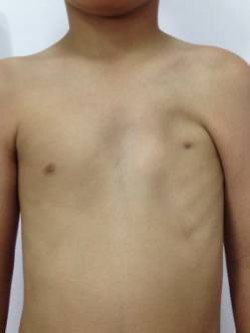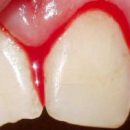Varieties of pathology

Voronko-shaped curvature (in the people «chest of shoemaker»).
This is the most common defect, from which the statistics claims, boys suffer more than girls. Chest (front of ribs, cartilage and cheese) indulgent to the spine. If you explore the family history of diseases of people suffering from this vice, you can see that pathology is inherited, so it is considered to be genetically determined.
As a result of the deformation, the chest volume decreases, and in the case of pronounced pathology, the spine is twisted, venous blood pressure changes, the full work of the lungs is disturbed, the heart shifts.
Than younger than the sick child, the more unnoticed pathology. With its consideration, the severity of the deformation of the chest increases. Because of the damage, the baby often overcomes vegetative disorders, he lags behind in physical development, he has bad immunity.
In this form of pathology, the power of respiratory movements, in contrast to the norm, is reduced by 3-4 times, gradually deformation becomes fixed. On her background they begin to develop scoliosis and kyphosis. Over time, the depth of the peaked chest increases, and therefore the state of respiratory and cardiovascular systems is aggravated.
Cilent chest («chicken breast»).
Pathology arises due to excessive growth of cartilage edges: the chest is issued ahead and makes children's breasts like a keel boat. With age, the degree of severity of the vice is only increasing.
Celene deformation of the chest does not affect the spine and internal organs, and the heart is modified - its form becomes like a drop. Children with this type of vice suffer from fast fatigue, rapid heartbeat and shortness of breath.
Flat thoracic.
Breasts are noticeably spitted. A child with such pathology is distinguished by asthenic physique: high growth, narrow shoulders and long limbs, low weight. He lags behind his peers in physical development and often suffers from colds.
Congenital cleft sternum (chest split).
May be complete or partial. Pulk appears in the early stages of the intrauterine development of the kid. Cleft is inclined to increase as children growled. This type of deformation is very dangerous: the front wall of the heart and the main major vessels remain without the protection of the sternum, they are covered directly with the skin (heart pulsation can be seen with the naked eye). The specificity of pathology requires immediate operational intervention, because the risk of mechanical injuries of internal organs in a child with congenital cleft sternum is extremely high.
Less common types of pathology include such types of deformation as: Poland syndrome (not only the chest, but also the spine with muscles) and the Currarino Silverman syndrome (Breast is strongly deployed).
Each type of deformation can be expressed in varying degrees: sometimes it looks like a minimal cosmetic defect, and in some cases the disruption of the musculoskeletal frame is bright signs of pathology.
At the place of the location of the bones modified as a result of the disease, the front, rear and side deformation of the chest.
Causes of the development of pathology

Primary diagnostics involves a visual inspection of a patient with a specialist, because bone distortion of this kind can be estimated even by external signs. Instrumental views include:
- X-ray, which gives a real pattern of deformation, its shape and degree of severity;
- Computer tomography, determining the features of the change of bones, the degree of squeezing with them of the lungs;
- Magnetic resonance imaging, which is carried out to get more information about the state of the bone-cartilage complex and soft tissues.
Treatment of pathology
For the degree of development of the disease, the presence of violations in the work of the heart and respiratory organs depends on the specificity and effectiveness of therapy. Promising in terms of treatment, the types of deformation (funk-shaped and celoid) are well corrected using massage, LFC, wearing special corsets, swimming, respiratory gymnastics and Physiotherapy. But if the pathology is very serious, it is impossible to correct this defect, but it is impossible to suspend its further development and ensure the normal operation of the internal organs. In such cases, you need to turn to surgical treatment.
For the correction of congenital funnel deformation of the chest use the method of a vacuum bell. The funnel is affected by vacuum to stimulate the bone-muscular corset to become «in place», stretch out. If this type of treatment does not supply due action, they are prescribed Sterochondroplastic. The most effective operation turns out when the patient is a child of 6-7 years.

Sterochondroplastics are performed as follows: transverse cuts are made on the chest to separate the chest muscles and the rib cartilage from the bones, the filling plate is inserted into the resulting cavity. The method is very effective, but it has one disadvantage: there are big inesthetical scars on the chest.
A minimally invasive operation on the NASS method is considered more inflicting in relation to the appearance of the chest. On the sides make cuts and insert metal plates for straightening and constant fixation of the sternum in the correct position. Children wear such «corset» 3-4 years, after which they are removed. During this period, the chest acquires a full view.
The nature of the treatment of the cylinder deformation of the chest depends on the characteristics of functional disorders and the degree of expression of pathology. In children, the disease is well amenable to correction with the help of a corset, which in most cases eliminates the need for surgery.
The situation with a flat thoracic can be significantly corrected using therapeutic physical education, breathing exercises, swimming. However, a cosmetic defect, which can cause numerous complexes, unfortunately, cannot be avoided.
The cleft of the chest is adjusted only by operation, the type of which depends on the age of the patient. For children, the sternum is excised and stitching in the midline: kones in kids are still pliable and flexible, therefore they can grow together. After a year, the operational intervention is more serious. The sternum is cut, the pathological gaps between its segments are filled with autotransplants, the heart is hiding under a plate made of titanium.
As a rule, in 95% of cases, operational treatment ends successfully, and only the units of patients need a re-operation.
Prevention of pathology

The acquired deformation of the chest can be avoided if you carefully monitor your health. So, special attention should be paid to the treatment of lung diseases.
MirSets recommends an early childhood to introduce a child with physical education and a variety of sports. Exercises aimed at strengthening the muscular corset of the chest (for example, press swing), one can be considered one hundred percent protection against possible bone curvature.









